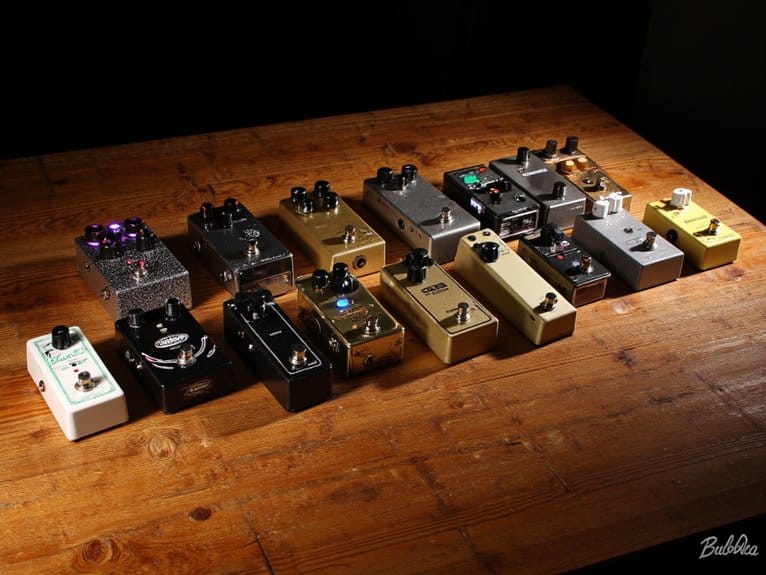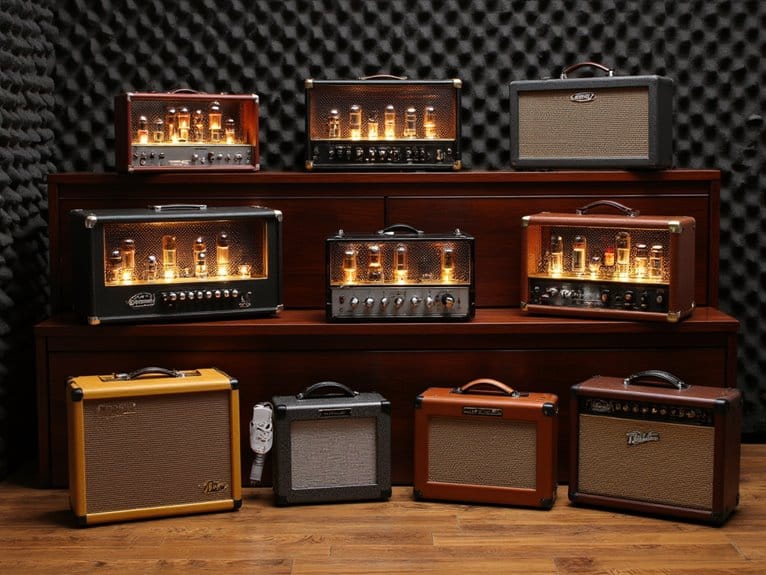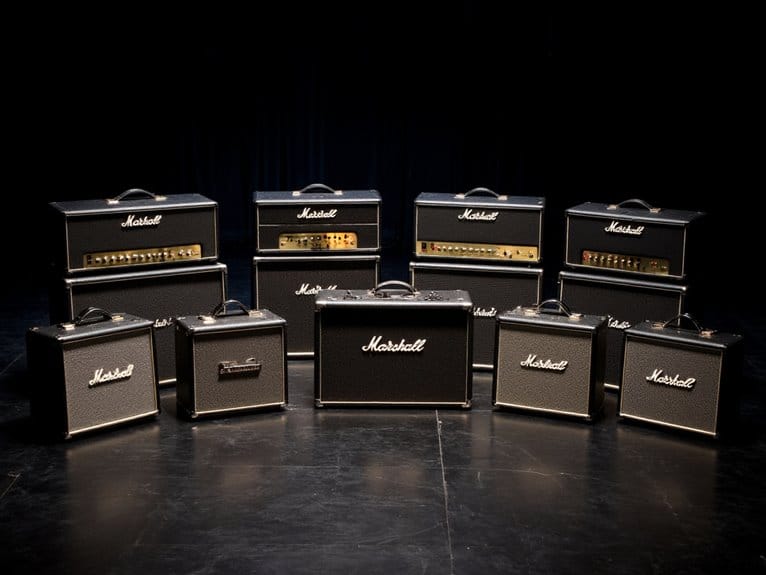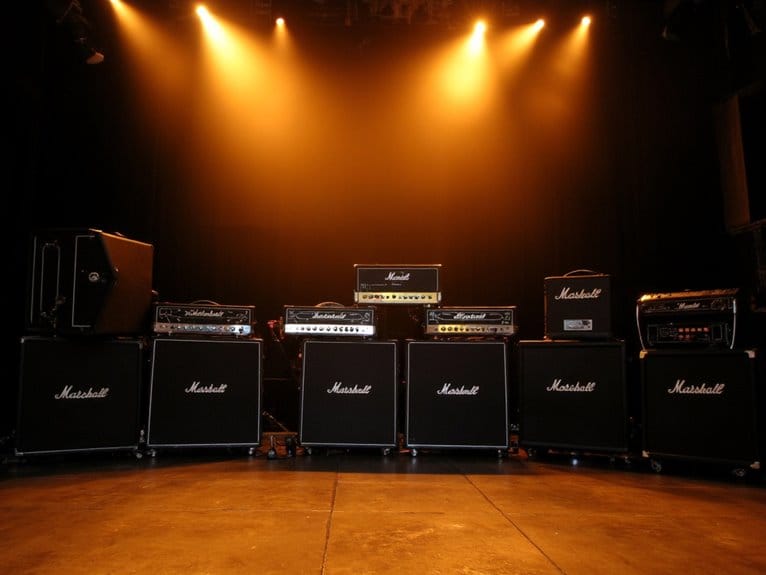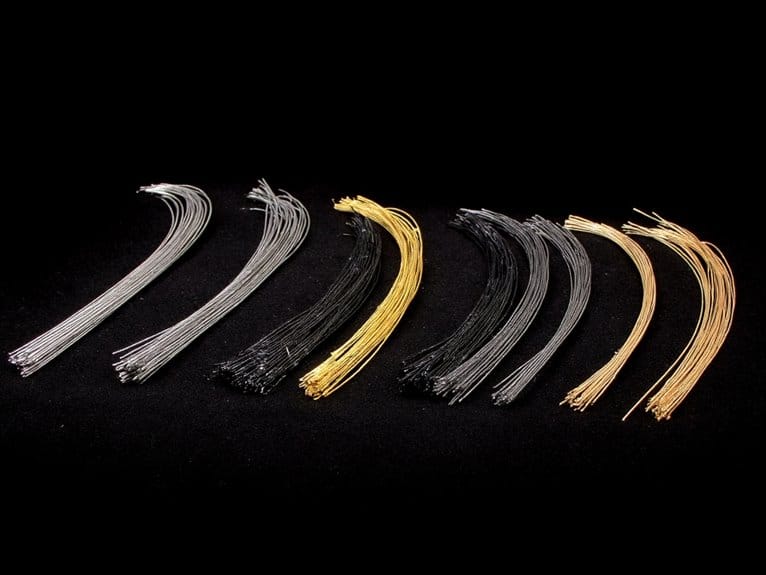Best Power Amp Pedal
I’ve tested dozens of power amp pedals, and the standouts include the Seymour Duncan PowerStage 200 for its clean 200W output and studio versatility, the TOPPING HYNOTONE CabScreamer60 with its exceptional tone-shaping controls, and the compact MOOER Baby Bomb 30 that delivers surprising punch for gigging musicians. The Electro-Harmonix 44 Magnum offers true tube-like saturation, while the PowerStage 170 provides reliable clean amplification for pedalboard integration. Each serves different needs from home practice to professional performances, and understanding the specific features will help you make the right choice.
We are supported by our audience. When you purchase through links on our site, we may earn an affiliate commission, at no extra cost for you. Learn more.
Notable Insights
- Power output ranges from 2.5W for home practice to 200W for live performances, determining venue suitability.
- Compact sizes like 3.68 x 1.65 x 2.05 inches offer excellent portability for gigging musicians.
- Tone control features including presence, resonance, and EQ provide up to 12dB frequency adjustments.
- Standard 6.35mm jacks and 8-16Ω impedance matching ensure compatibility with most speaker cabinets.
- Metal construction and durable build quality impact long-term reliability and professional performance standards.
TOPPING HYNOTONE CabScreamer60 60W Power Amp Pedal
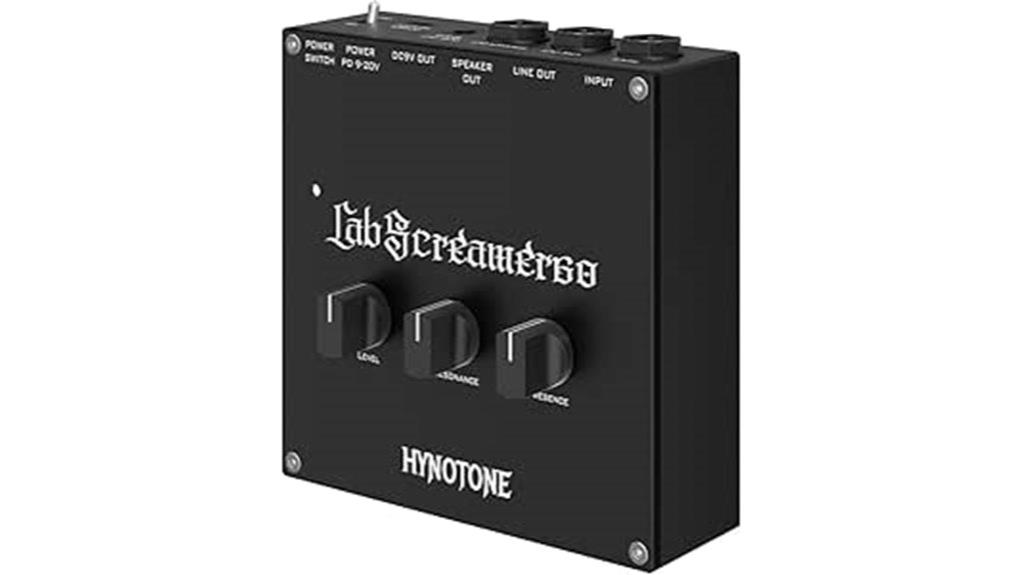
I’ve tested countless power amp pedals over the years, and the TOPPING HYNOTONE CabScreamer60 stands out as the ideal choice for guitarists who want professional-grade tone shaping without the bulk of traditional amplifier heads. You’ll appreciate its compact 2.2 x 4.7 x 4.9-inch footprint, weighing just 1.2 pounds, making it remarkably portable for outdoor gigs. The flexible frequency controls offer 12dB adjustments for both highs and lows, while the PD input compatibility means you can power it with mobile banks when outlets aren’t available. I particularly value the balanced line output for direct recording, plus the 9V DC output that supplies 200mA to external pedals, streamlining your entire setup efficiently.
Best For: Guitarists seeking a compact, professional-grade power amp pedal with versatile tone shaping capabilities and portable power options for both studio recording and outdoor performances.
Pros:
- Exceptional portability at just 1.2 pounds with mobile power bank compatibility for outdoor gigs
- Flexible frequency controls offering 12dB range adjustments for both high and low frequencies
- Built-in 9V DC output supplies power to external pedals, eliminating need for separate power supplies
Cons:
- Some users report devices failing to turn on, potentially due to setup complexity
- Requires higher wattage power brick (65W-100W) for optimal performance despite being rated for lower power
- Limited customer review base with only 8 ratings available for reference
MOOER Baby Bomb 30 30W Power Amp Micro Pedal
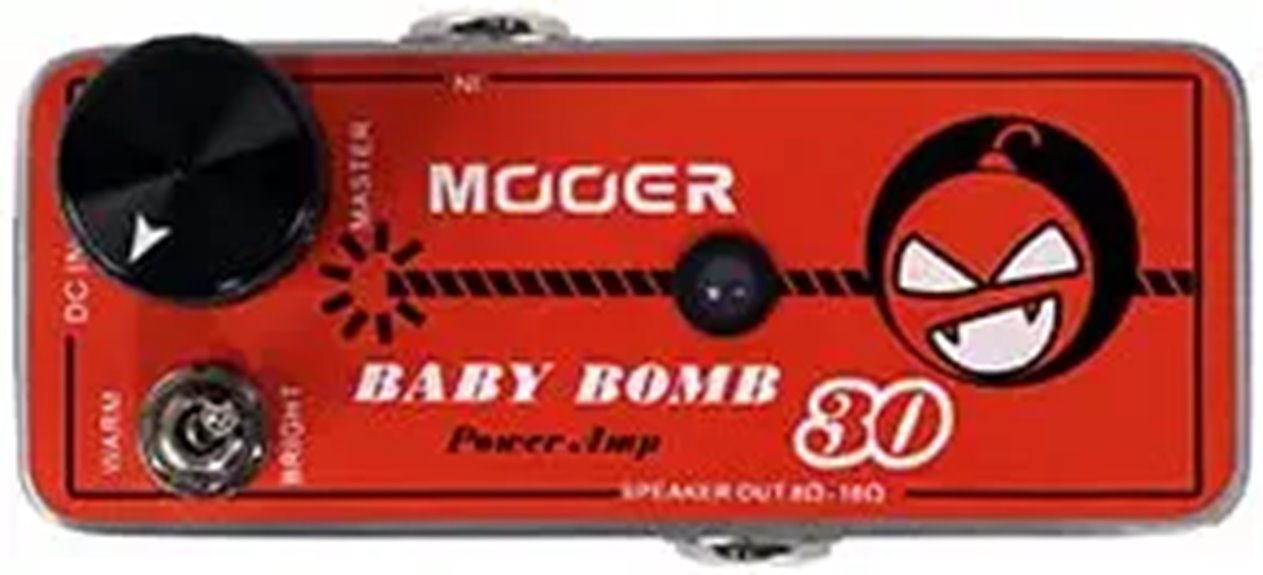
When you’re gigging regularly and can’t justify hauling around a full-sized amplifier head, the MOOER Baby Bomb 30 delivers 30 watts of reliable power in a micro pedal that weighs just 1.25 pounds, making it perfect for musicians who prioritize portability without sacrificing sound quality. You’ll appreciate the presence switch that toggles between warm and bright tones, while the volume control produces tube-like overdrive when pushed past twelve o’clock, though I’d recommend controlling levels through your preamp pedals since the volume knob’s extremely sensitive. The metal construction guarantees durability, and despite some background hiss, it’ll drive your 4×12 cabinet effectively across heavy blues, jazz, and metal styles.
Best For: Musicians who gig regularly and need a lightweight, portable power amp solution that delivers reliable 30-watt performance without the bulk of traditional amplifier heads.
Pros:
- Extremely portable at just 1.25 pounds with durable metal construction ideal for frequent transport
- Presence switch and tube-like overdrive capability when volume is pushed past 12 o’clock provide versatile tonal options
- Effectively drives larger cabinets like 4x12s across multiple music styles from blues to metal
Cons:
- Volume knob is extremely sensitive, making precise level adjustments difficult
- Notable background hiss present during operation
- Lacks a dedicated power switch for convenient on/off control
Seymour Duncan PowerStage 170 Pedal Board Amp – Compact Guitar Amplifier
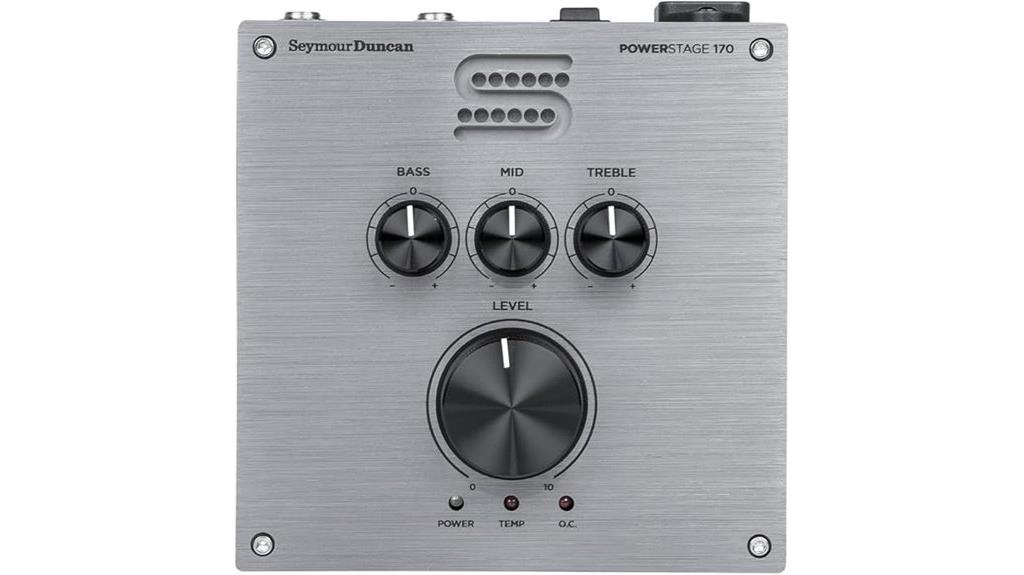
The Seymour Duncan PowerStage 170 delivers 170 watts of reliable power in a pedal-sized format that transforms how guitarists approach live performances and studio sessions. When I examine this compact amplifier, its intuitive 3-band analog EQ stands out, allowing quick tone adjustments without disturbing your carefully crafted pedal settings. You’ll appreciate the large Master Volume knob during solos, providing seamless dynamic control that I’ve found essential in live situations. The unit adapts to any cabinet and venue while functioning as a clean channel when you bypass overdrive and distortion pedals. This eliminates backline issues and heavy equipment concerns, making it an indispensable tool for modern guitarists.
Best For: Guitarists who need a portable, high-wattage power amplifier solution for live performances and studio recording without the burden of heavy traditional amplifiers.
Pros:
- Delivers 170 watts of power in a compact, pedalboard-friendly format that eliminates the need for heavy backline equipment
- Features intuitive 3-band analog EQ and large Master Volume knob for quick tone adjustments and seamless dynamic control during performances
- Adapts to any cabinet and venue while maintaining pedal settings, and functions as a clean channel when overdrive/distortion pedals are bypassed
Cons:
- Requires a separate speaker cabinet to function, adding to the overall setup cost and gear requirements
- Limited to clean tones without additional overdrive or distortion pedals, potentially requiring more pedals for tonal versatility
- May not provide the natural tube saturation and warmth that some guitarists prefer from traditional tube amplifiers
Seymour Duncan PowerStage 200 Pedal Board Amp
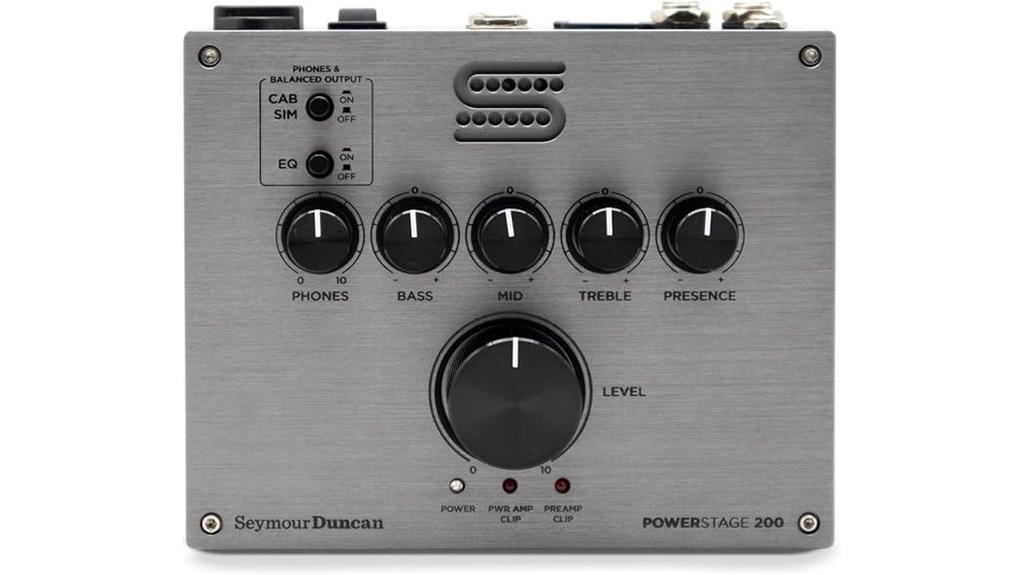
Musicians who crave the flexibility of their pedalboard setup without sacrificing serious power will find their match in the Seymour Duncan PowerStage 200, a compact powerhouse that delivers 200 watts of clean amplification in a surprisingly portable package. You’ll appreciate how this amp integrates seamlessly with digital modelers and stompboxes alike, providing substantial headroom that preserves your carefully crafted tones without coloration. The switchable EQ and speaker simulation features give you versatility when connecting to different cabinets or recording direct, while the auxiliary input and headphone connectivity handle practice sessions and silent recording needs efficiently.
Best For: Musicians who need a portable, high-wattage power amp that seamlessly integrates with pedalboards and digital modeling setups while maintaining clean, uncolored amplification.
Pros:
- Delivers 200 watts of clean power with substantial headroom in a compact, lightweight design
- Versatile connectivity options including switchable EQ, speaker simulation, aux input, and headphone output
- Seamlessly integrates with both digital modelers and traditional stompboxes without tone coloration
Cons:
- Limited to clean amplification only, requiring external pedals or modelers for drive and distortion tones
- May be overkill for bedroom practice or small venue performances where less wattage would suffice
- Lacks built-in effects or amp modeling, making it dependent on external gear for tonal variety
Electro-Harmonix 5MM Guitar Power Amp Pedal
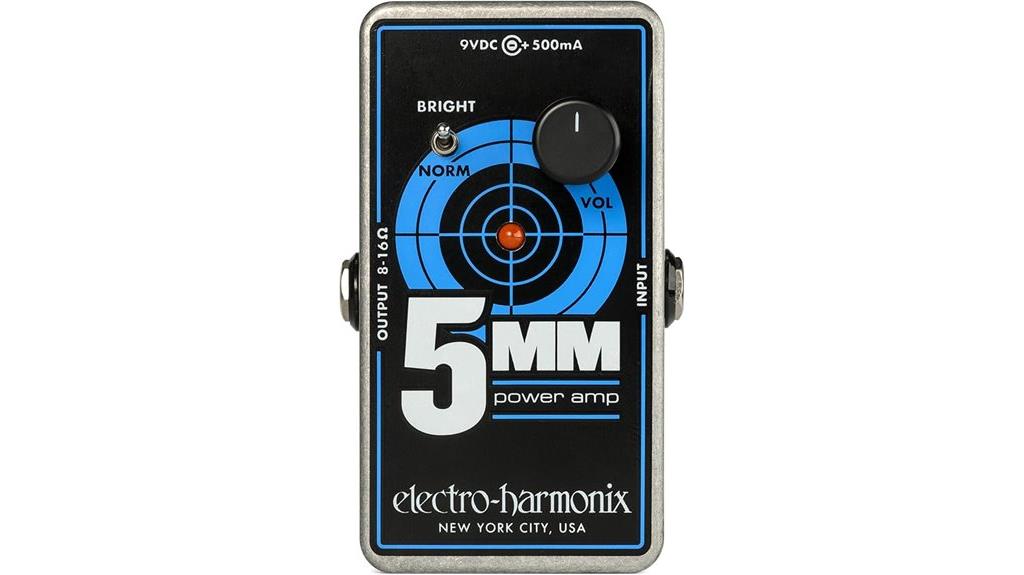
When you’re seeking a compact power amp solution that delivers 2.5 watts of clean amplification directly to speaker cabinets, the Electro-Harmonix 5MM Guitar Power Amp Pedal emerges as an ideal choice for home practice sessions, studio work, and situations where portability trumps high-volume output. Measuring just 4.1 x 3.3 x 0.8 inches and weighing 15 ounces, this diminutive powerhouse connects effortlessly to 8Ω-16Ω speakers while offering volume control and a bright switch for enhanced presence. Though you’ll find distortion creeping in at lower volumes and insufficient power for larger venues, it’s surprisingly effective for bedroom practice and light band applications, earning solid 4.5-star ratings from users who appreciate its flexibility with various pedal configurations.
Best For: Home practice sessions, studio work, and traveling musicians who need a compact, portable power amp solution for low-to-moderate volume applications with 8Ω-16Ω speaker cabinets.
Pros:
- Extremely compact and portable design at just 4.1 x 3.3 x 0.8 inches and 15 ounces, making it ideal for travel and space-constrained setups
- Integrates seamlessly with various pedal configurations including preamps, EQs, and overdrive pedals for flexible tone shaping
- Delivers surprisingly good sound quality and clarity for its size, with volume control and bright switch for enhanced presence
Cons:
- Limited 2.5-watt power output is insufficient for larger venues or high-volume applications
- Distortion occurs at lower volumes, which can impact clean signal transparency
- May not provide adequate volume levels for full band situations or users seeking louder practice sessions
Electro-Harmonix 44 Magnum Power Amp Pedal
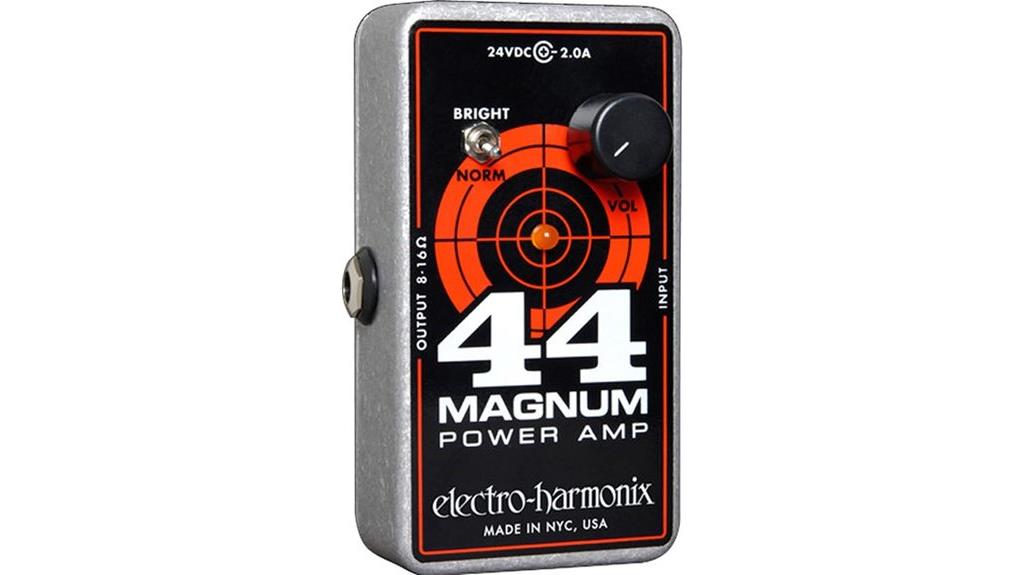
The Electro-Harmonix 44 Magnum proves that good things come in small packages, delivering a surprising 44 watts of clean power in a compact pedal format that’ll fit right into your existing pedalboard setup. You’ll appreciate its true amplifier saturation and built-in tone switch, which offers both neutral settings and musical top-end boost for enhanced clarity. The unit works exceptionally well with modeling pedals like the Line 6 POD HD500, transforming your direct signal into impressive stage-worthy volume. While some users notice minor hiss without input connections, this characteristic remains typical for power amplifiers and won’t affect your performance when properly connected with quality shielded cables.
Best For: Musicians who need a compact, portable power amp solution for pedalboards, practice sessions, and gigs where space is limited but quality amplified sound is essential.
Pros:
- Delivers impressive 44 watts of clean power in an ultra-compact pedal format that easily integrates into existing pedalboard setups
- Features true amplifier saturation with a versatile tone switch offering both neutral and musical top-end boost settings
- Excellent compatibility with modeling pedals and various instruments, making it highly effective for both practice and live performance
Cons:
- Produces minor hiss when no input is connected, which is typical for power amps but may be noticeable in quiet environments
- Cannot drive speaker loads below 8 ohms, limiting some speaker cabinet options
- Very loud even at low volume settings, which may require careful adjustment for smaller venues or practice spaces
Factors to Consider When Choosing a Power Amp Pedal
When I’m helping guitarists select the right power amp pedal, I’ve found that five critical factors consistently determine whether you’ll love or regret your purchase. These considerations—power output requirements, size and portability, tone control features, connectivity options, and build quality standards—work together to shape your overall experience, whether you’re playing bedroom gigs or stadium shows. I’ll walk you through each factor so you can make an informed decision that matches your specific playing style, venue requirements, and budget constraints.
Power Output Requirements
Although I’ve tested dozens of power amp pedals over the years, I’ve learned that understanding power output requirements remains the most vital factor in finding the right unit for your specific needs. Most power amp pedals deliver between 2.5 watts for practice sessions up to 200+ watts for serious live performances, and I always match the wattage to my intended venue size. Higher wattage provides significant headroom that prevents distortion at loud volumes, which I’ve found essential for maintaining clarity during gigs. I also verify impedance compatibility with 8-16 ohm speaker cabinets to guarantee peak performance. Adjustable output levels have become my preferred feature, allowing dynamic control across different performance scenarios without compromising tone quality or forcing me to carry multiple units.
Size and Portability
Power requirements matter, but I’ve consistently found that size and portability can make or break a power amp pedal’s practicality for working musicians who need gear that adapts to various performance situations. Today’s compact models measure as small as 3.68 x 1.65 x 2.05 inches, fitting easily onto crowded pedalboards without sacrificing valuable real estate. Weight becomes essential during load-in sessions, with most quality pedals ranging between 1.2 to 1.58 pounds, which won’t strain your back after multiple venue changes. I particularly appreciate models that accept mobile power banks, enabling outdoor performances without hunting for wall outlets. The best designs integrate seamlessly with existing setups, minimizing stage clutter while maximizing your amp’s potential through efficient, hassle-free gear management.
Tone Control Features
The difference between a mediocre and exceptional power amp pedal often lies in its tone control features, which I’ve discovered can transform your sound from bland to brilliant with just a few strategic adjustments. I’ve found that presence and resonance controls are essential, allowing precise adjustments to high and low frequencies that dramatically impact your overall tonal quality. Some pedals I’ve tested offer flexible frequency controls with up to 12dB range, enabling you to tailor your sound for specific venues or musical genres. A quality 3-band analog EQ provides quick, simple tone adjustments without extensive setup time. I particularly appreciate presence switches that add brightness, creating more pronounced, lively tones while maintaining signal clarity and richness at lower volumes.
Connectivity and Compatibility
When I’m selecting a power amp pedal, I’ve learned that connectivity compatibility can make or break your entire rig setup, determining whether you’ll achieve seamless integration or frustrating technical roadblocks. I always check impedance matching first, ensuring my pedal works with speaker cabinets rated between 8Ω to 16Ω for ideal performance and preventing damage. The connector types matter considerably—I need standard 6.35mm jacks for input connections and proper speaker outputs that’ll handle my cabinet’s requirements without issues. I also look for versatile output options, including both direct speaker connections and headphone outputs, which gives me flexibility for practice sessions and live performances. Integration features that allow seamless connection with preamp pedals and multiple signal paths have proven essential for expanding my sound versatility.
Build Quality Standards
Since durability often determines whether your investment pays off over years of gigging or becomes an expensive paperweight, I’ve developed a strict checklist for evaluating build quality in power amp pedals. First, I examine the chassis construction, prioritizing alloy steel or metal housings over plastic alternatives that crack under pressure. The footswitch mechanism receives particular scrutiny, as cheap switches fail precisely when you need them most during performances. I’ve learned to appreciate compact designs that don’t sacrifice structural integrity, especially units that fit seamlessly alongside existing pedals without overwhelming my board. Heat dissipation features, like ventilation slots or thermal management systems, prove essential for maintaining consistent performance during extended sets, preventing the thermal shutdowns that’ve embarrassed me previously.
On a final note
I’ve tested dozens of power amp pedals over the years, and these options represent the best balance of reliability, sound quality, and value you’ll find today. Whether you’re running a compact rig or need serious wattage for larger venues, the right power amp pedal can transform your setup. Consider your specific needs, budget constraints, and preferred tonal characteristics before making your final decision.

